Visibility Matters
Lindsay Lohan and the New Definition of “Out”
One of the old files tetrieved
bySarah Warn
September 17, 2008
I stopped keeping up with media’s obsessive coverage of 22-year-old Lindsay Lohan a few years ago, just before she entered rehab for the first time.
It wasn’t just because I lost interest in Lohan. In the last few years, the press has become obsessed with reporting on, and arguably creating, depressing news stories about young women engaged in self-destructive or self-obsessed behavior.
Television shows, entertainment and gossip websites, newspapers and magazines were overflowing with reports on Britney Spears’s marriage troubles, ongoing custody problems, and career missteps; the latest feud between Paris Hilton and her Simple Life co-star Nicole Richie; or Lohan’s public battle with her father, her drinking problems, and her inability to show up to work on time.

Around that time on AfterEllen.com, I instituted what I only semi-jokingly referred to as the “no Britney, Paris, or Lindsay” rule, which was intended to keep our writers from covering these topics (and others like them) on the site. Not only because they’re boring, annoying, and repetitive, but because I don’t take pleasure from reading or writing about young women self-destructing.
So when the first rumors and photos began circulating about a relationship between Lohan and 30-year-old DJ Samantha Ronson a few years ago, I ignored them — because of the aforementioned rule, and because I was skeptical.
As the months wore on and the stories persisted, I realized there might be some truth to the rumors, after all, but thought Lohan was just doing the bi-for-show thing that I have seen so many female celebrities do over the years (see: t.A.T.u, Drew Barrymore, Madonna, Bai Ling, etc.).
I began to reconsider recently when it finally became clear to me that the two were most likely involved in a serious relationship, and that Lohan had begun to turn her life around. She is now working successfully again (guesting on Ugly Betty, starring in the indie film Labor Pains), and instead of stories about DUIs, rehab, and workplace reprimands, the tabloids and gossip blogs only have Lohan’s ongoing feud with her father and speculation about her relationship with Ronson to write about. (OK, and still the occasional punching of a paparazzo — Rome wasn’t built in a day).
Ugly Betty co-star star Eric Mabius told OK! magazine this week that the actress was “fun to work with” and that “it was nice to see her girlfriend Sam visiting the set and offering her that support.”
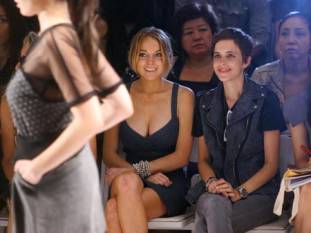

All of which is good news, but puts me and other entertainment journalists with ethics (yes, we do exist) in a bit of a quandary.
REDEFINING “OUT”
Ronson and Lohan have never verbally defined their relationship in public, and as a general rule (with some exceptions), we don’t out celebrities on AfterEllen.com.
But this rule used to be much easier to follow.
In the olden days of, say, the 1990s, you had to say actually say the words “I’m gay” or “I’m in a romantic relationship with so-and-so” to some kind of reputable press outlet to be considered openly gay, or “out.” Otherwise, you were considered “in” (or closeted). (See: Neil Patrick Harris pre-2006, or Ellen DeGeneres pre-1997.)
There are and will continue to be those who come out with words, and those who choose not to come out at all. But beginning in the early part of this decade, a new way of being out emerged that was characterized by living openly in a same-sex relationship and not denying or hiding it from the press, but refusing to actually define it with words.
Jodie Foster is a prominent example of this. We didn’t cover Foster on AfterEllen.com when I started the site in 2002, because I didn’t consider her to be “out.”
We have begun writing about her more in the last few years, however, as Foster began to live her life a little more openly — thanking her alleged then-partner Cydney Bernard in a speech, putting her children’s full names (which include “Bernard”) on display, and wearing what she referred to as an “eternity ring” — even though she has never openly declared her sexual orientation or defined her relationship with Bernard.
In an interview with More magazine in Sept. 2007, Foster declined to answer direct questions about her relationship with Bernard, as usual, saying “that would be trivializing my life, selling it for a magazine.”
But, she added, “I don’t have any problems with anybody reporting on my life.”
This is what has changed — both the increased willingness of the mainstream press to actually report on the lives of gay, lesbian and bisexual celebrities who have not openly declared their sexual orientation, and the increased willingness of (some) celebrities to let them.
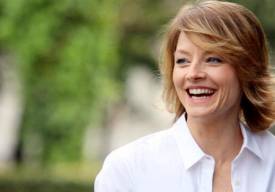
here have always been gay, lesbian and bisexual celebrities who have lived openly in their day-to-day lives, but stayed closeted in their public life. This was only possible because the press went along with it. Rock Hudson, Raymond Burr, Greta Garbo, and Bessie Smith are just a few of the names of people whose sexual orientation has only been revealed to the broader public posthumously.
Less reputable tabloids have always been willing to expose the “secrets” of celebrities, but their information was tainted by a lack of credibility, in part because readers didn’t usually know or have reason to trust the people behind the tabloids.
Their distribution was also limited, confined primarily to supermarket checkout lines and paid subscriptions.
But the internet suddenly allowed millions of Americans to access this information in the privacy of their own home, and provided by influential online editors, writers and bloggers, whose credibility has been painstakingly built over time, and whose personality (in contrast to the tabloids impersonal style) builds trust and intimacy with readers.
The line between what topics were reserved for tabloids versus more mainstream news outlets also became blurred. As information about celebrities’ personal lives became more widely available, and reported more online, traditional press outlets were forced to address previously out-of-bounds topics in order to stay relevant.
This included reporting on celebrities who have not announced they are gay, lesbian, or bi, but live their lives as if they are.
And that’s why we find ourselves in 2008 opening up the latest issue of one of the top women’s magazines and reading, with little fanfare, about the “no brainer” rumors that one of Hollywood’s most-talked-about young actresses is in a serious lesbian relationship.
LIVING OUT LOUD
Lohan and Ronson have accompanied each other almost everywhere for over two years now. They attend public events together, like last week’s VMA’s and Mercedes-Benz Fashion Week, and they wear matching rings.
Lindsay’s mom has spoken out in support of their relationship (without specifying what it is); Samantha’s brother’s now ex-girlfriend described the two as “a lovely couple” in an interview; and there have been more paparazzi photos of them hanging out, kissing, and even grocery-shopping together than most people can track of.
Lohan with Ronson at an Entertainment Weekly party in Aug. 2006
Last Saturday, the two women walked through LAX smiling and holding hands, and on Sunday, they jointly posted a note on Lindsay’s MySpace blog encouraging their fans to vote for Democratic presidential candidate Barack Obama, and calling out Republican Vice-Presidential candidate Sarah Palin on her anti-gay views. “Is our country so divided that the Republicans best hope is a narrow minded, media obsessed homophobe? Palin’s Desire to “save and convert the gays”-really??” they wrote in the blog post, which they signed “xoxo Lindsay and Samantha.” (The post was widely quoted by the media, but most press outlets only attributed it to Lohan.)
Lohan might not be on the cover of Time saying “Yep, I’m Gay” (she declined an offer from OK! magazine to come out on their cover), but she’s on the cover of Marie Claire this month talking about what a great influence Samantha has been on her life — refusing to confirm the exact nature of their relationship, but talking about their matching tattoos, and how excited she is to be buying a house with an unnamed someone.
Meanwhile, every gossip and mainstream entertainment site is reporting on rumors of an engagement between Lohan and Ronson (Lohan’s rep denies it’s true), MTV News reported Monday that “Lindsay Lohan Calls Out Sarah Palin for Homophobia”, and Radar magazine recently published a lengthy article devoted to the relationship between the two women.
(Comedian Bridget McManus and I were interviewed separately for the Radar article and we were both misquoted significantly enough that we contacted the magazine for a retraction; Radar’s editor denies any inaccuracy, but when pressed, admitted the reporter did not use a recording device, but quoted us from notes she took during our very lengthy phone interviews.)
All of which begs the question: Is an announcement even necessary when your behavior already tells the story?
Actress Saffron Burrows (My Own Worst Enemy, The Bank Job), 35, came out as bisexual in 1999, telling Tatler magazine in 2000, “If I was going to make a broad generalization, I’d say that I prefer the company of women. … On one level, privacy is important but, on another level, I have no desire to deny certain things.”
But in the almost 10 years since then, Burrows has rarely been photographed with her alleged partner, actress Fiona Show (the Harry Potter movies), 50. They almost never attend public events together, and don’t talk about each other in interviews. Yet both are listed on Britain’s Pink List each year, and openly referred to by most of the press as a couple.
The separation of the actresses’ personal and private lives is obviously intentional, and I’m not criticizing it. But if actions truly speak louder than words, you could argue that Lohan and Ronson are more “out” than Burrows and Shaw.
There are other couples who are redefining the word “out,” like Broadway actress Cherry Jones (24), 51, and Sarah Paulson (Cupid, The Spirit), 33, who attended the Tony Awards together in 2005 as a couple, but only occasionally discuss their relationship publicly.
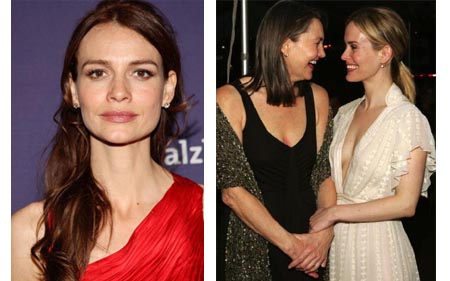
So what really makes you “out” today? Does it qualify if you live your life openly with a partner of the same gender, but don’t actually say you’re living your life openly with a partner of the same gender?
I believe the answer is yes, but I also believe editors and writers across the country will be struggling with this issue for the next few years — including the staff at our brother site, AfterElton.com, which covers gay and bisexual men in entertainment and the media.
of photos of him with his then-boyfriend Reichen Lehmkuhl were first published on gossip sites online, then referenced in mainstream media outlets. In this situation, Bass was clearly outed, because the photos were taken without his knowledge and consent, so AfterElton.com did not write about him as openly gay prior to his statement in People.
Portia de Rossi was outed in tabloids in 2003 much the same way, but did not come out until much later. We did publish an article on AfterEllen.com back then about the outing of de Rossi, but primarily in order to explore what we saw as the beginnings of the sea change that has now occurred.
In contrast, couples like Lohan and Ronson, and Jones and Paulson, and of course, Ellen DeGeneres and Portia de Rossi, have all willingly allowed their relationship to be captured by the public, albeit to varying degrees.
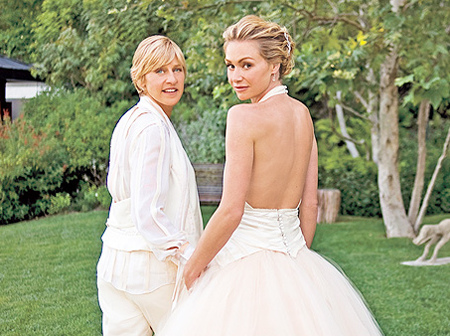
It’s a fine line sometimes, I’ll admit, but one that is increasingly possible — and necessary — to draw.
Straight celebrities don’t announce their heterosexuality, we just make assumptions from their behavior. In the past, we haven’t been able to makes the same conclusions about celebrities in same-sex relationships, because their day-to-day behavior was not widely reported on, so an announcement was necessary to counter the prevailing assumption of heterosexuality.
That’s not so true anymore.
OUT AND INSPIRING
One of the most encouraging aspects to Lohan’s story is the positive influence it may have on those young women who have followed her life and career over the last several years.
Not only will they see a very popular (if controversial) young woman living openly in a lesbian relationship, but the press is giving her girlfriend credit for helping Lohan get her life back on track.
In July, L.A. police Chief William Bratton said at a press conference that he had less problems with the paparazzi since Lohan had “gone gay,” adding that Lohan’s relationship with Ronson had “quieted her down” (Lohan’s response was to chastise Bratton publicly by saying, “Police chiefs shouldn’t get involved in everyone else’s business when it comes to their personal life. It’s inappropriate.”)
In the Marie Claire interview, the reporter asked Lohan outright whether Samantha is responsible for the positive changes in her life, to which Lohan replied, “[Samantha’s] a great person. And she’s a great influence on people around her. But I think that anything that’s changed in my life is because of me. I’ve gone through it and I’ve had to deal with it and I’ve made the decision to move forward.”
While I believe Lohan is right to take most of the credit herself, the fact that the mainstream media is attributing her positive turnaround in part to a romantic relationship with Ronson is something we never would have seen even five years ago.
This can’t help but make things just a little bit easier for teenagers struggling with their sexuality.
“I’m sure there are a lot of girls out there who are so much more comfortable because they love Mean Girls and Lindsay’s dating a girl,” actress Kirsten Dunst recently told Harper’s Bazaar. “I think that couldn’t be better.”
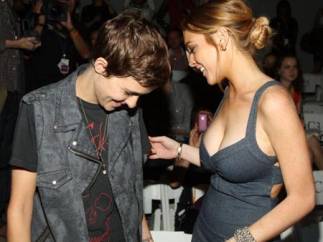
I agree, and moving forward, we’ll begin covering women like Lohan on AfterEllen.com more — women who are “out” in their actions, if not in their words. It’s going to be a little murkier from an editorial standpoint, and require more subjective judgment calls, but that’s just the reality of the entertainment landscape today.
I still reserve the right not to write about young female celebrities who represent all the wrong things, though. I’ll just call it the “No Britney, Paris or Tila” rule now.
